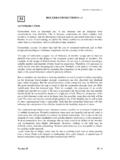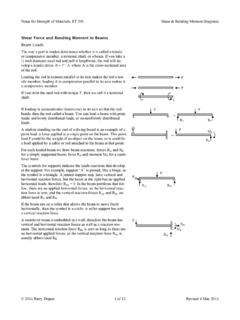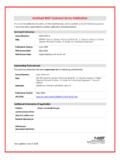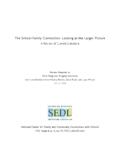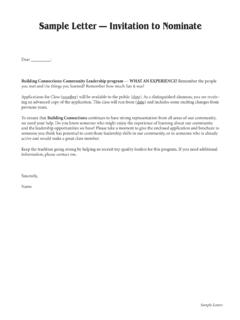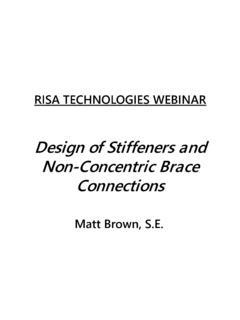Transcription of Mechanical Connections in Wood Structures: …
1 Chapter Purpose and ScopeA connection consists of two or more members joined with one or moremechanical fasteners. In most wood structures, connectionss are one of themost important, but least understood, components. Connections providecontinuity to the members and strength and stability to the system. Con-nections may consist entirely of wood members but frequently involve theconnection of wood to steel or other members. Of the failures observed inwood structures, most are attributed to improper Connections design, con-struction (fabrication) detail, or is a diversity of Mechanical fasteners and Connections , eachhaving design criteria developed at different times in history. Some designpractices are based on substantial research, some on minimal research,some on extrapolated research, and some on rules of thumb.
2 Thus designpractices of Mechanical Connections in wood structures are fragmented,and can be confusing, contradictory, and have various inherent levels manual is a collection of state-of-the-art information on mechani-cal connectionss in wood structures. Mechanical connectionss are defined asthose where fasteners penetrate the wood; adhesive Connections are notincluded. It is intended to help design professionals apply engineeringjudgment for those many connection details not covered by standarddesign codes. It will provide an overview of current design basis andrelated A. Soltis, and Michael Ritter, Research Engineers, USDA Forest Product Labo-ratory, Madison, WI12 WOOD STRUCTURESThe Mechanical Connections included in this manual are generally lim-ited to those constructed with types of fasteners commonly used in theUnited Mechanical fastener types included are: Chapter 2 Nails, Spikes,and Staples; Chapter 3 Lag Screws and Wood Screws; Chapter 4 Bolts,Drift Bolts, and Pins; Chapter 5 Metal Connector plates; and Chap-ter 6 Timber design procedures are based on the strength of a single fastener strength is modified for material, geometry, and serviceconditions.
3 Limited information is available on serviceability or stiffnessdesign requirements for most Mechanical fasteners are specified in theNational Design Specification (NDS) for Wood Construction (AmericanForest & Paper Association, 1991). There are substantial changes in theNDS from previous editions that are discussed in subsequent under development is a Load and Resistance Factor Design (LRFD)Manual (American Forest & Paper Association) which will parallel requirements for Mechanical fasteners in glulam constructionare included in the Timber Construction Manual (TCM) (American Insti-tute of Timber Construction, 1985). This manual concentrates on design aspects for single or multiple fas-tened Connections . Only limited information is provided on connectiondetailing and qulaity of Types of Fasteners and Connections Mechanical connnections are consturcted using two general fastenertypes dowel and bearing.
4 Dowel type fasteners, such as nails, screws,and bolts, transmit either lateral or withdrawal loads. Lateral loads aretransmitted by bearing stresses developed between the fastener and themembers of the connection . Withdrawal loads are axial loads parallel tothe fastener axis transmitted through friction or bearing to the connectedmaterials. Metal connector plates are a special case of dowel-type fasten-ers; they combine the lateral load actions of dowel fasteners and thestength properties of the metal Connections transmit lateral loads only. Bearing-type fas-teners, such as shear plates and split ring connetors, transmit shear forcesthrough bearing on the connected Connections are combination of dowel and bearing-typefasteners. They generally support one structural member and are con-nected to another member by a combination of dowel and bearing of a fastener for a specific design application depends on thetype of connection and the requried strength capacity.
5 Each connectionINTRODUCTION3must be designed to transmit forces adequately and provide satisfactoryperformance for the life of the structure without causing splitting, crack-ing, or excessive deformation of the wood members. A brief description oftie types of fasteners included in subsequent chapters of this manual isgiven Nails, Spikes, and are the most common type ofmechanical fasteners used in construction. Nails resist either lateral orwithdrawal forces or a combination of the two. There are many variationsin types of nails as well as shapes, treatments, coatings, finishes, sizes, are long, nail-like fasteners designed to connect larger sizedelements. Staples are made of thin wire and consist of two legs and acrown. Staples have a variety of sizes, points, coatings, and quality. Theyare available in clips and coils to permit use in pneumatically operatedstaplers.
6 Staples are also used in low-strength or nonstructural connec-tions and resist lateral and withdrawal Lag Screws and Wood screws are threaded fastenerswith a square or hex head that are placed in wood members by tur-ning with a wrench. Although lag screws have a lower lateral strength thancomparable bolts, lag screws are advantageous when an excessive boltlength is required or when access to one side of a connection is screws are usually made of steel or brass and are classifiedaccording to material, type, finish, head shape, and shank diameter. Bothlag and wood screws provide lateral and withdrawal Bolts, Drift Bolts, and are the most common woodfastener for Connections where moderately high lateral strength is re-quired. They are also used in tension Connections where forces are appliedparallel to the bolt axis. The bolts used for structural Connections arestandard machine bolts and drift pins are long unthreaded bolts, steel pins, or steeldowels that are driven in prebored holes.
7 Drift bolts include a head on oneend while no head is provided on pins. Drift bolts and pins are used inlateral Connections for large wood members. They are not suitable forwithdrawal connectionss because of their low resistance to Metal Connector connector plates, commonly calledmetal plate connectors, steel truss plates, truss plates, or plates, are usedextensively in wood trusses. These plates are proprietary products but are4 WOOD STRUCTURES generally made of light gauge structural quality steel with zinc orzinc-aluminum alloy coatings or stainless steel metal connector platehas integral teeth and is manufactured to various lengths, widths, andthicknesses. It is designed to transmit lateral loads; however, in trussessome moment is transferred as a result of change in geometry of a truss asit Timber connectors are steel, malleable iron,ceramic, or fiberglass rings or plates placed between members and par-tially inserted into each adjacent member held together by a bolt, lagscrew, or spike grid.
8 They are used in lateral connectionss only and providethe highest lateral strength of all fasteners because of the large bearingarea provided by the MATERIALSS pecification requirements for each type of Mechanical fastener arediscussed in their respective chapters. In general, most fastener material isspecified by ASTM standards and include yield and ultimate wood properties are specified in the NDS (American Forestand Paper Association, 1991). BASIC DESIGN CRITERIA GENERAL PROCEDUREThe strength of wood connectionss is often limited by the resistance ofthe wood in bearing or withdrawal rather than the strength of the a result, connection design is affected by many of the same factors thatinfluence the strength properties of wood. In addition to the type, number,and size of fasteners, Connections strength also depends on such factors asthe wood species, direction and duration of load, and conditions of use.
9 Insome cases the strength of the connection may also be limited by thecapacity of the connected values for different types of nonproprietary fasteners are givenin building codes and specifications in either tabular or equation values are based on one fastener, installed and used under specifiedconditions. Allowable design loads are determined by adjusting tabulatedor calculated values with adjustment factors. When more than one fas-tener is used in a connection , the design value is the sum of the designvalues for the individual fasteners times an adjustment factor ( ). Itshould be noted that the design criteria and tabulated loads are limited toconnections involving the same type of fastener. Methods of analysis andINTRODUCTION5test data for Connections made with more than one type of fastener havenot been developed and this type of connection is not basic design procedures for Connections are similar to those forstructural components.
10 For a given connection and type of fastener thedesigner the tabulated load for one fastener appropriate for thespecies group of the connected adjustment factors to the tabulated value to reflect specificapplications and conditions of the modified value for lateral loading conditions other thanparallel or perpendicular to grain, when the design load for one fastener by the total number fasten-ers in the connection and apply a group adjustment factor if the net section and verify the capacity of the the connection to ensure adequate fastener placement Design CriteriaThe strength of a connection is related to the species (specific gravity)of wood in which the fastener is installed and to the strength of thefastener. Lateral strength of small (nails, staples, screws) and large (lagscrews, bolts, drift bolts, and pins) diameter dowel Connections are theo-retically derived from the European yield theory (Aune and Patton-Mallory,1986; Soltis and Wilkinson, 1987).
